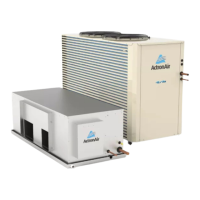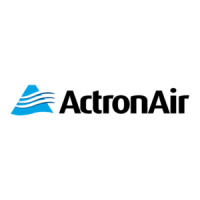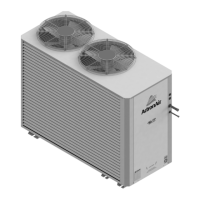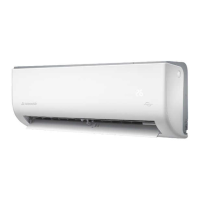Do you have a question about the ActronAir ESP Platinum QUE and is the answer not in the manual?
Verify unit, components, and accessories upon receipt for damage and accuracy.
Ensure installation complies with all applicable local, state, and federal codes and standards.
Details the variable capacity refrigeration circuit for optimal efficiency and comfort.
Describes EC fans for efficient, quiet airflow, controlled by intelligent controllers.
Highlights the use of axial fans and inverter compressor for performance and quiet operation.
Follow all safety instructions, warning labels, and WH&S regulations during installation and service.
Ensure proper electrical disconnection and wiring in accordance with regulations and diagrams.
Ensure appliance is used safely, especially by children, and that guards are secured.
DANGER: Risk of Electrocution. Turn off power and use LOCK-OUT/TAG-OUT procedures.
Recover and recycle refrigerants responsibly, adhering to codes and regulations.
Use appropriate equipment for minimal refrigerant emissions and proper system evacuation.
Perform leak tests on any repaired section of the refrigeration system before charging.
Verify unit ratings, ensure level foundation, install anti-vibration rubber, and allow clearances.
Ensure wiring complies with local regulations, diagrams, and uses correct circuit protection.
Unit compatibility, refrigerant type, and handling regulations must be followed.
Identifies key external and internal components of the outdoor unit.
Details the components within the outdoor unit's electrical panel.
Provides dimensional drawings and weight specifications for specific models.
Provides dimensional drawings and weight specifications for specific models.
Specifies minimum clearances for maintenance, service, and airflow for optimal performance.
Illustrates service and airflow clearances for stacking two units in a specific configuration.
Illustrates service and airflow clearances for stacking two units in a different configuration.
Illustrates service and airflow clearances for stacking three units in a specific configuration.
Details the procedure and equipment required for lifting the unit using a crane.
Explains the safe procedure for lifting and moving the unit using a forklift.
Instructions for removing mounting screws to access the unit.
Step-by-step guide to safely remove the unit's access panel.
Refers to Section 09 for details on installing field pipes and piping procedures.
Guidelines and precautions for piping and brazing with R410A refrigerant.
Table showing equivalent pipe lengths for various elbow types and sizes.
Explains how to calculate total equivalent field pipe length including losses.
Details recommended pipe sizes and lengths for different outdoor models.
Step-by-step instructions for using nitrogen bleed during pipe installation.
Details the process and importance of pressure testing the system.
Outlines the multi-stage evacuation process to remove moisture and non-condensables.
Specifies where to find the unit's wiring diagram for installation and service.
Installer responsibilities for power supply, protection devices, and earthing.
Importance of checking voltage balance to prevent motor overheating.
Table showing recommended circuit breaker sizes and cable specifications.
Details the main power supply connection requirements for the unit.
Specifies the power cable connection between outdoor and indoor units.
Outlines the cable type and connection for the wall controller.
Details the low voltage data cable for indoor to outdoor communication.
Illustrates the internal wiring connections for the indoor unit and controllers.
Shows the main wiring connections for the outdoor unit's control board and VSD.
Guidelines for preparing and connecting the data cable, including shielding.
How to connect DRM input cables to the ODU CPU board terminals.
Description of different Demand Response Management modes and their operating ranges.
Explains the RUN/FAULT relay outputs and their connection to the condenser CPU board.
Important notes and precautions for charging R410A refrigerant.
Table listing factory charge, pre-charged length, and additional charge per meter for models.
Defines key parameters like LLT, SCT, SLT, and SST for charging.
Procedure for adjusting refrigerant charge for optimal performance.
Method to check and adjust sub-cooling based on pressure/temperature chart.
Method to check and adjust superheat for optimal evaporator performance.
Table showing target sub-cool and superheat values for different models.
Table providing pressure-temperature relationships for R410A refrigerant.
General guidance on regular servicing by licensed technicians.
DANGER and WARNING notices regarding live electrical connections and hazardous voltage.
List of common inspection and maintenance tasks to be performed annually.
Instructions for cleaning the outdoor unit's condenser coils for optimal performance.
Precautions regarding detergent use and water entry into electrical compartments.
Detailed steps for cleaning the condenser coils, including detergent application and rinsing.
Checklist for electrical parts like PCBs and connections with service frequency.
Maintenance frequency and methods for indoor unit parts like casing, insulation, fan, motor, etc.
Maintenance frequency and methods for outdoor unit parts like casing, insulation, fan, compressor, etc.
Identifies causes and remedies for the system failing to start.
Troubleshooting air flow problems in the indoor unit.
Addresses issues with insufficient cooling or heating performance.
Explains normal steam/water emission during defrost and heating operations.
Troubleshooting problems with adjusting set temperatures or zone limits.
Diagnoses reasons for the compressor running but the system not cooling.
Addresses issues related to the outdoor coil freezing over.
Explains causes of odour from the indoor unit and remedies.
Lists status codes related to unit operation modes (OFF, Cooling, Heating, Defrost).
Details fault codes originating from the indoor unit sensors and components.
Lists fault codes related to outdoor unit sensors, components, and communication.
Fault codes specifically associated with the Variable Speed Drive.
Continues listing fault codes for the Variable Speed Drive.
Explains the difference between VAV and Non-VAV zones in the Platinum System.
Covers turning system ON/OFF and adjusting zone differentials via controllers.
Discusses zone sensor usage, master control operation, and in-line fan issues.
Information on zone barrel piggybacking and compatibility with ActronAir barrels.
Details on calibrating sensors and assigning zones during commissioning.
How zones modulate airflow regardless of fan mode and common zone usage.
Steps to run the system at 100% capacity for tasks like re-charging.
Lists key components for outdoor units CRQ2-16AT and CRQ3-18AT with part numbers and quantities.
Lists key components for outdoor units CRQ5-21AT and CRQ5-24AT with part numbers and quantities.
Verify unit, components, and accessories upon receipt for damage and accuracy.
Ensure installation complies with all applicable local, state, and federal codes and standards.
Details the variable capacity refrigeration circuit for optimal efficiency and comfort.
Describes EC fans for efficient, quiet airflow, controlled by intelligent controllers.
Highlights the use of axial fans and inverter compressor for performance and quiet operation.
Follow all safety instructions, warning labels, and WH&S regulations during installation and service.
Ensure proper electrical disconnection and wiring in accordance with regulations and diagrams.
Ensure appliance is used safely, especially by children, and that guards are secured.
DANGER: Risk of Electrocution. Turn off power and use LOCK-OUT/TAG-OUT procedures.
Recover and recycle refrigerants responsibly, adhering to codes and regulations.
Use appropriate equipment for minimal refrigerant emissions and proper system evacuation.
Perform leak tests on any repaired section of the refrigeration system before charging.
Verify unit ratings, ensure level foundation, install anti-vibration rubber, and allow clearances.
Ensure wiring complies with local regulations, diagrams, and uses correct circuit protection.
Unit compatibility, refrigerant type, and handling regulations must be followed.
Identifies key external and internal components of the outdoor unit.
Details the components within the outdoor unit's electrical panel.
Provides dimensional drawings and weight specifications for specific models.
Provides dimensional drawings and weight specifications for specific models.
Specifies minimum clearances for maintenance, service, and airflow for optimal performance.
Illustrates service and airflow clearances for stacking two units in a specific configuration.
Illustrates service and airflow clearances for stacking two units in a different configuration.
Illustrates service and airflow clearances for stacking three units in a specific configuration.
Details the procedure and equipment required for lifting the unit using a crane.
Explains the safe procedure for lifting and moving the unit using a forklift.
Instructions for removing mounting screws to access the unit.
Step-by-step guide to safely remove the unit's access panel.
Refers to Section 09 for details on installing field pipes and piping procedures.
Guidelines and precautions for piping and brazing with R410A refrigerant.
Table showing equivalent pipe lengths for various elbow types and sizes.
Explains how to calculate total equivalent field pipe length including losses.
Details recommended pipe sizes and lengths for different outdoor models.
Step-by-step instructions for using nitrogen bleed during pipe installation.
Details the process and importance of pressure testing the system.
Outlines the multi-stage evacuation process to remove moisture and non-condensables.
Specifies where to find the unit's wiring diagram for installation and service.
Installer responsibilities for power supply, protection devices, and earthing.
Importance of checking voltage balance to prevent motor overheating.
Table showing recommended circuit breaker sizes and cable specifications.
Details the main power supply connection requirements for the unit.
Specifies the power cable connection between outdoor and indoor units.
Outlines the cable type and connection for the wall controller.
Details the low voltage data cable for indoor to outdoor communication.
Illustrates the internal wiring connections for the indoor unit and controllers.
Shows the main wiring connections for the outdoor unit's control board and VSD.
Guidelines for preparing and connecting the data cable, including shielding.
How to connect DRM input cables to the ODU CPU board terminals.
Description of different Demand Response Management modes and their operating ranges.
Explains the RUN/FAULT relay outputs and their connection to the condenser CPU board.
Important notes and precautions for charging R410A refrigerant.
Table listing factory charge, pre-charged length, and additional charge per meter for models.
Defines key parameters like LLT, SCT, SLT, and SST for charging.
Procedure for adjusting refrigerant charge for optimal performance.
Method to check and adjust sub-cooling based on pressure/temperature chart.
Method to check and adjust superheat for optimal evaporator performance.
Table showing target sub-cool and superheat values for different models.
Table providing pressure-temperature relationships for R410A refrigerant.
General guidance on regular servicing by licensed technicians.
DANGER and WARNING notices regarding live electrical connections and hazardous voltage.
List of common inspection and maintenance tasks to be performed annually.
Instructions for cleaning the outdoor unit's condenser coils for optimal performance.
Precautions regarding detergent use and water entry into electrical compartments.
Detailed steps for cleaning the condenser coils, including detergent application and rinsing.
Checklist for electrical parts like PCBs and connections with service frequency.
Maintenance frequency and methods for indoor unit parts like casing, insulation, fan, motor, etc.
Maintenance frequency and methods for outdoor unit parts like casing, insulation, fan, compressor, etc.
Identifies causes and remedies for the system failing to start.
Troubleshooting air flow problems in the indoor unit.
Addresses issues with insufficient cooling or heating performance.
Explains normal steam/water emission during defrost and heating operations.
Troubleshooting problems with adjusting set temperatures or zone limits.
Diagnoses reasons for the compressor running but the system not cooling.
Addresses issues related to the outdoor coil freezing over.
Explains causes of odour from the indoor unit and remedies.
Lists status codes related to unit operation modes (OFF, Cooling, Heating, Defrost).
Details fault codes originating from the indoor unit sensors and components.
Lists fault codes related to outdoor unit sensors, components, and communication.
Fault codes specifically associated with the Variable Speed Drive.
Continues listing fault codes for the Variable Speed Drive.
Explains the difference between VAV and Non-VAV zones in the Platinum System.
Covers turning system ON/OFF and adjusting zone differentials via controllers.
Discusses zone sensor usage, master control operation, and in-line fan issues.
Information on zone barrel piggybacking and compatibility with ActronAir barrels.
Details on calibrating sensors and assigning zones during commissioning.
How zones modulate airflow regardless of fan mode and common zone usage.
Steps to run the system at 100% capacity for tasks like re-charging.
Lists key components for outdoor units CRQ2-16AT and CRQ3-18AT with part numbers and quantities.
Lists key components for outdoor units CRQ5-21AT and CRQ5-24AT with part numbers and quantities.
| Brand | ActronAir |
|---|---|
| Model | ESP Platinum QUE |
| Category | Air Conditioner |
| Language | English |












